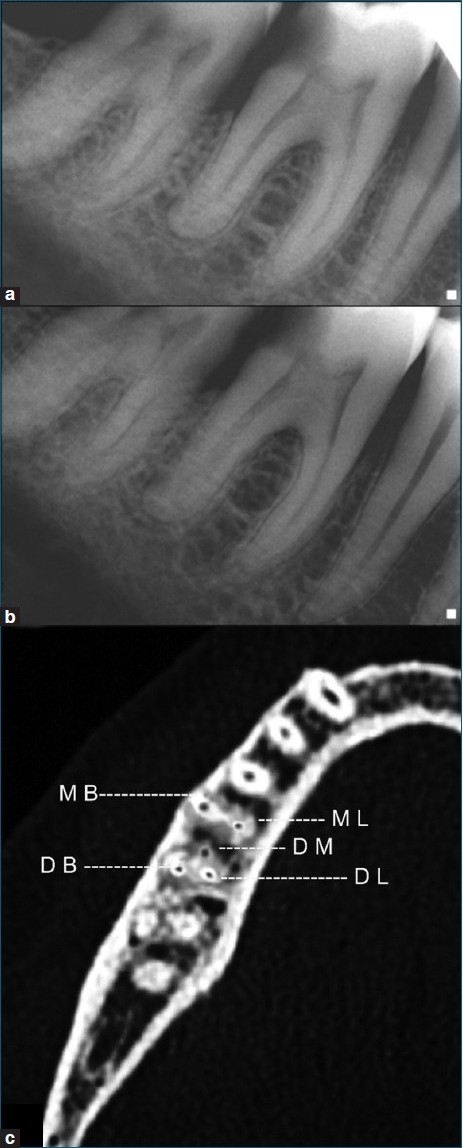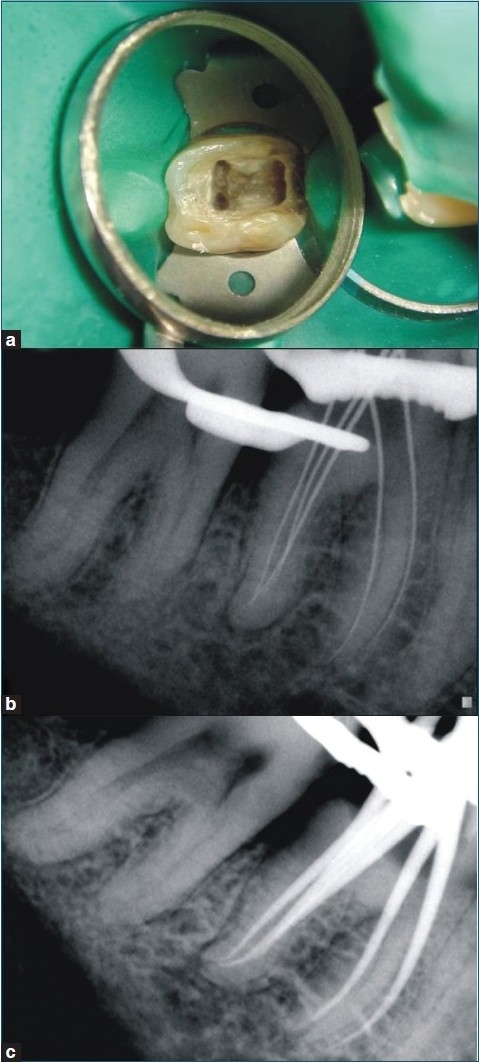Abstract
The use of spiral computed tomography serves as a boon in endodontic diagnosis of complex anatomic variations. The present case demonstrates the spiral tomographic evaluation and endodontic management of a mandibular first molar with 5 canals (2 mesial and 3 distal canals), which is a very rare anatomic variant. Such anatomic variations should be taken into account in day to day endodontic practice to ensure a high degree of clinical success.
Keywords: Anatomic variation, endodontic treatment, mandibular first molar
INTRODUCTION
Endodontic therapy requires a thorough knowledge of root canal morphology to adequately shape and clean the canal system. Proper care and attention should be directed in identifying and negotiating extra roots and canals.
In a radiographic study of extracted teeth Goel et al[1] reported mandibular first molars had 3 mesial canals in 13.3% of specimens, 4 mesial canals in 3.3% of specimens, and 3 distal canals in 1.7% of specimens. Furthermore, their study showed that 1 apical foramen was present in 30%, 2 in 60%, 3 in 6.7%, and 4 in 3.3% of the cases. Previous reports have described the mandibular first molar with 3 mesial canals,[2–3] but few have reported a mandibular first molar with more than two distal canals.[4] The presence of 3 canals in the distal root of mandibular first molar has been reported to have an incidence of 0.2%–3%.[4]
The scope of spiral computed tomography (SCT) in endodontic diagnosis is becoming broader day by day. Spiral CT provides a better resolution as compared with other scanning methods, such as cone beam CT. Chandra et al[5] successfully employed SCT in managing the middle distal canal in the mandibular first molar.
The present case report describes the SCT evaluation and endodontic treatment of a mandibular first molar with 5 canals (2 mesial and 3 distal canals).
CASE REPORT
A 60-year-old male patient reported to the Department of Conservative Dentistry and Endodontics with a complaint of pain in the mandibular right first molar. On clinical oral examination, mandibular right first molar of the patient had a deep carious lesion. Digital radiograph (Schick Technologies, NY, USA) of mandibular right first molar revealed the presence of 2 distinct roots. Radiograph taken from a mesial angulation revealed the presence of multiple canals in the distal root. In order to assess the complex root canal anatomy, informed consent was taken from the patient and a spiral CT of the mandibular right first molar was planned. SCT evaluation (64 slice Multi-detector row CT, Siemens, USA) of the involved tooth revealed the presence of 3 distal canals and 2 mesial canals [Figure 1a,b, and c]. The dosage was kept within the maximum permissible limits as defined for the general population. The SCT provided a resolution of 0.6 mm, which is not obtainable with other scanning methods, such as cone beam CT.
Figure 1.

(a) Preoperative diagnostic radiograph; (b) diagnostic radiograph taken from a mesial angulation; and (c) spiral CT scan of the involved tooth showing the presence of 3 distal and 2 mesial canals
Endodontic treatment of the involved tooth was decided and access cavity preparation was done using access opening bur kit (Dentsply Maillefer, Switzerland) under rubber dam isolation. Four distinct canal orifices (mesiobuccal, mesiolingual, distobuccal, and distolingual) were located and negotiated using K-Flex file ISO 15 (Dentsply Maillefer) at the first instant. Careful exploration of the pulp chamber was done using an endodontic explorer (DG16), and a third distal canal was explored between the distobuccal and distolingual canal orifices. The middle distal canal joined the distolingual canal in the apical third of the root. Working length measurement was done using Elements diagnostic apex locater (SybronEndo, USA,) and it was confirmed by a digital radiograph (Schick Technologies, NY, USA) [Figure 2a, b, and c]. Root canal shaping was done using K-Flex hand files (Dentsply) and obturation was done with Resilon and Epiphany Obturation System (SybronEndo, USA). The access cavity was sealed with a temporary restorative material. The patient was recalled for the permanent restoration. Radiographic evaluation at 6-month recall revealed a healthy periodontium [Figure 3a, b].
Figure 2.

(a) Access opening photograph showing the clinical view of canal orifices; (b) working length determination confirmatory radiograph; and (c) master cone selection radiograph
Figure 3.

(a) Postoperative obturation radiograph; and (b) radiograph at 6-month recall
DISCUSSION
Clinicians routinely misinterpret that a given tooth will contain a predetermined number of roots and canals. However, the literature review shows a greater amount of variation in the number of roots and canals.
The presence of multiple canals in the mandibular first molar is most of the time seen in the mesial root,[2–3] but a few cases have reported a mandibular first molar with more than 2 distal canals.[4] The canals may be independent throughout their course in the root with a separate apical foramen or they may join either of the two main canals.
An accurate diagnosis of extra roots/canals can avoid a lot of procedural errors or a missed canal during root canal treatment. Sophisticated diagnostic aids, such as SCT can be an invaluable tool in diagnosis of such anatomic variations. The main benefit in employing spiral CT over conventional radiography is that it allows the clinician to observe at multiple slices of the tooth roots and their canal systems.[6]
Since its application in endodontics in 1990, CT scanning has become very popular with the clinicians in the past few years. The successful use of spiral CT in the assessment of complex endodontic cases has been reported by various authors. Chandra et al[5] in a case report did successful endodontic management of a mandibular first molar with 3 distal canals confirmed with the aid of SCT.[5]
CONCLUSIONS
Clinicians should have a thorough knowledge of the several anatomic variations seen in case of mandibular first molars. An accurate diagnosis of an extra root/canal before treatment is important to facilitate the endodontic procedure, and to avoid missed canals. The use of SCT in endodontic diagnosis serves as an asset in diagnosing complex root canal anatomies to achieve a high degree of success.
Footnotes
Source of Support: Nil
Conflict of Interest: None declared.
REFERENCES
- 1.Goel NK, Gill KS, Taneja JR. Study of root canals configuration in mandibular first permanent molar. J Indian Soc Pedod Prev Dent. 1991;8:12–4. [PubMed] [Google Scholar]
- 2.Ricucci D. Three independent mesial canals in the mesial root of a mandibular first molar. Endod Dent Traumatol. 1997;13:47–9. doi: 10.1111/j.1600-9657.1997.tb00010.x. [DOI] [PubMed] [Google Scholar]
- 3.Baugh D, Wallace J. Middle mesial canal of the mandibular first molar: A case report and literature review. J Endod. 2004;30:185–6. doi: 10.1097/00004770-200403000-00015. [DOI] [PubMed] [Google Scholar]
- 4.Kottoor J, Sudha R, Velmurugan N. Middle distal canal of the mandibular first molar: A case report and literature review. Int Endod J. 2010;43:714–22. doi: 10.1111/j.1365-2591.2010.01737.x. [DOI] [PubMed] [Google Scholar]
- 5.Chandra SS, Rajasekaran M, Shankar P, Indira R. Endodontic management of a mandibular first molar with three distal canals confirmed with the aid of spiral computerized tomography: A case report. Oral Surg Oral Med Oral Pathol Oral Radiol Endod. 2009;108:e77–81. doi: 10.1016/j.tripleo.2009.06.017. [DOI] [PubMed] [Google Scholar]
- 6.Patel S, Dawood A, Whaites E, Ford PT. New dimensions in endodontic imaging: Part 1. Conventional and alternative radiographic systems. Int Endod J. 2009;42:447–62. doi: 10.1111/j.1365-2591.2008.01530.x. [DOI] [PubMed] [Google Scholar]


